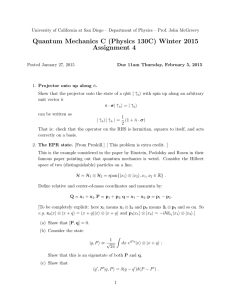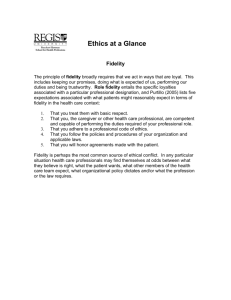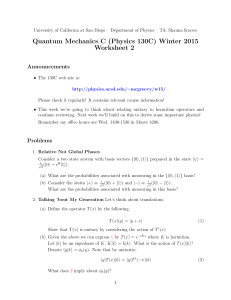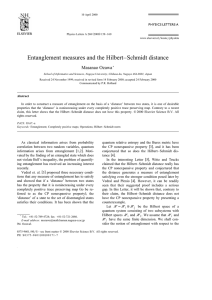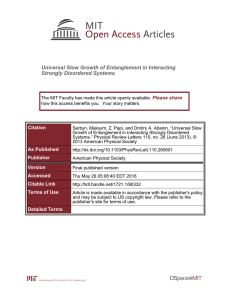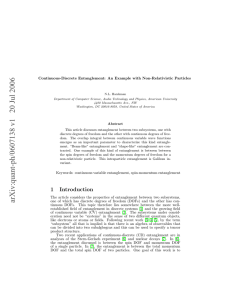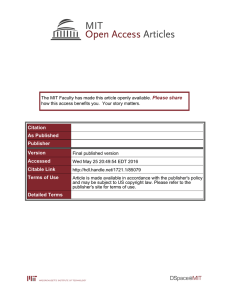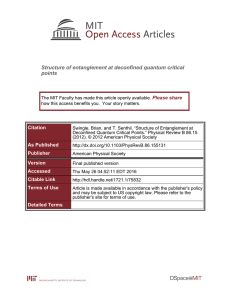Quantum Mechanics C (130C) Winter 2014 Assignment 4
advertisement
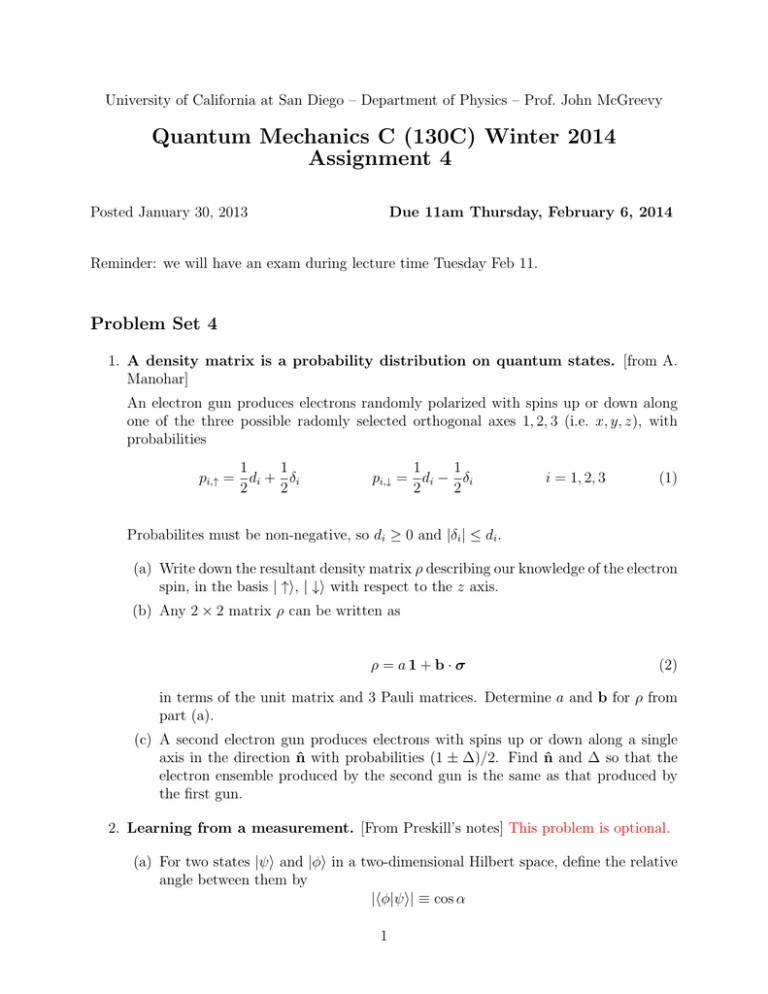
University of California at San Diego – Department of Physics – Prof. John McGreevy Quantum Mechanics C (130C) Winter 2014 Assignment 4 Posted January 30, 2013 Due 11am Thursday, February 6, 2014 Reminder: we will have an exam during lecture time Tuesday Feb 11. Problem Set 4 1. A density matrix is a probability distribution on quantum states. [from A. Manohar] An electron gun produces electrons randomly polarized with spins up or down along one of the three possible radomly selected orthogonal axes 1, 2, 3 (i.e. x, y, z), with probabilities 1 1 pi,↑ = di + δi 2 2 1 1 pi,↓ = di − δi 2 2 i = 1, 2, 3 (1) Probabilites must be non-negative, so di ≥ 0 and |δi | ≤ di . (a) Write down the resultant density matrix ρ describing our knowledge of the electron spin, in the basis | ↑i, | ↓i with respect to the z axis. (b) Any 2 × 2 matrix ρ can be written as ρ = a1 + b · σ (2) in terms of the unit matrix and 3 Pauli matrices. Determine a and b for ρ from part (a). (c) A second electron gun produces electrons with spins up or down along a single axis in the direction n̂ with probabilities (1 ± ∆)/2. Find n̂ and ∆ so that the electron ensemble produced by the second gun is the same as that produced by the first gun. 2. Learning from a measurement. [From Preskill’s notes] This problem is optional. (a) For two states |ψi and |φi in a two-dimensional Hilbert space, define the relative angle between them by |hφ|ψi| ≡ cos α 1 with 0 ≤ α ≤ π/2. Suppose the states are selected at random from an ensemble of states uniformly distributed over the Bloch sphere. (The statement that the state is uniformly distributed on the Bloch sphere means the following: the probability that the state is |ψi = | ↑n̂ i for n̂ of the form n̂ = (sin θ cos ϕ, sin θ sin ϕ, cos θ) with angles in the intervals (θ, θ + dθ) and (ϕ, ϕ + dϕ) is Prob (θ, ϕ) dθdϕ, with sin θ , Prob(θ, ϕ) = 4π the uniform distribution over the unit two-sphere.) Find the probability distribution for α. [Hint: to answer this question, we can choose a basis such that |φi = (1, 0) and just integrate over the direction of |ψi.] Extra credit: Redo the previous problem for two states in an N -dimensional Hilbert space. Now ‘selected at random’ means that the normalized vector |ψi is chosen from a distribution which is uniform on the (real!) (2N − 1)-sphere of states. (This is called the Haar measure on HN and has the virtue of being invariant under unitary rotations of the state.) In this case, we can replace the parametrization in (3) by |φi = (1, ~0), |ψi = (eiϕ cos θ, ψ ⊥ ), (3) where now eiϕ parametrizes a circle of radius cos θ, and |ψ ⊥ i is a vector that lies on a (real!) (2N − 3)-sphere of radius sin θ (and is chosen from the uniform distribution over this sphere). (b) Fidelity of a random guess. A density matrix ρ is said to approximate a pure state |ψi with fidelity F ≡ hψ|ρ|ψi. (4) (Why is this a good name? Define an observable which gives 1 if the state is ψ and 0 if the state is orthogonal to ψ. The fidelity is the probability that the outcome is 1 if we measure this observable in the state ρ.) Imagine that a state |ψi on a 2-dimensional Hilbert space is selected at random as above, and suppose we guess randomly that the state is |φi. On average, what will be the fidelity of our guess? [Hint: since the fidelity is basis-independent, we can find the average fidelity by fixing φ to a convenient value, rather than averaging over it.] Extra credit: Redo this part in an N -state Hilbert space. (c) How much do we learn from a measurement? When we make a measurement, we collect information and cause a disturbance – an unknown state is replaced with a different state about which something is known. Suppose that after randomly selecting a one-qbit pure state as in the previous problem, we 2 perform a measurement of the spin along the ẑ-axis. This measurement prepares a state described by the density matrix ρ = hψ|P↑ |ψiP↑ + hψ|P↓ |ψiP↓ , where P↑,↓ are the projectors onto the σ z eigenstates. Define fidelity as above in eqn. (4). On average, with what fidelity does the density matrix ρ represent the initial state |ψi? [The improvement in F compared to the answer in the previous problem is a crude measure of how much we learned by making the measurement.] Extra credit: Redo this part in an N -state Hilbert space. Show that the ratio of F after measurement to F before measurement approaches 2 at large N . 3. Measures of entanglement In the problems below, consider a bipartite system H = HA ⊗ HB , with the factors not necessarily of the same dimension. Consider a state of this system |ai = N X M X air |iiA ⊗ |riB . i=1 r=1 (a) We defined the Schmidt number of the state |ai to be the rank of the matrix air . Show that this is the same as the number of nonzero eigenvalues of ρA = trB |aiha| . Show that it’s also the same as the number of nonzero eigenvalues of ρB = trA |aiha| . [Hint: To solve this problem, it’s useful to take advantage of our ability to change basis. In particular, the problem does not depend on what basis we choose for HA and HB . If w were a Hermitian matrix, we could find a basis where it was diagonal, by using its eigenvectors as the basis elements. w is not Hermitian (and not even square in general), but there is still something we can do: such a matrix has right eigenvectors (elements of HB ) and left eigenvectors (elements of HA and they can be used to choose basis cleverly. In particular, any matrix has a singular value decomposition (SVD) of the form w = U T ΛV wir = UijT Λjs Vsr . where U and V are unitary (basis transformations) and Λ is a diagonal matrix (the entries are the ‘singular values’, which are in fact real and positive). Notice that Λ is not square. It looks like λ1 0 0 0 λ2 0 λ 0 0 0 0 1 if M > N . Λjs = 0 0 λ3 if N > M or Λjs = 0 λ2 0 0 0 0 0 0 0 0 λ3 0 0 js 0 0 0 js 3 (In the examples I chose (M, N ) = (3, 5) and (5, 3) respectively.) And U is N × N and V is M × M . So we can choose a new basis for Ha which is the image of our old one under U : |i0 i ≡ U |ii. Similarly for Hb : |r0 i ≡ V |ri. In this basis, we hvae X |wi = Λi0 r0 |i0 i ⊗ |r0 i i0 r 0 and Λ is diagonal. ] Besides the Schmidt number, another measure of entanglement between two subsystems is the entanglement entropy (or von Neumann entropy), defined to be SA = −trρA log ρA . [The logarithm of a Hermitian operator canP be defined by considering the spectral P decomposition: if A = a aPa then log A = a log(a)Pa .] (b) Show that if |ai is not an entangled state of A and B then SA = 0. Equivalently, show that −trρ log ρ = 0 if ρ is a pure state. (c) What’s the maximum possible value of the entanglement entropy for a state of a qbit? (d) Show that if the whole system is in a pure state |aiha|, then the entanglement entropy for ρA is the same as that of ρB : SA = SB . [Hint: use your ability to choose the basis again.] (e) Entanglement cannot be created locally Define a local unitary to be an operator of the form UA ⊗ UB where UA,B acts only on HA,B . These are the operations that can be done by actors with access only to A or B. Show that by acting on a state of H with a local unitary we cannot change the Schmidt number or the entanglement entropy of either factor. Consider both the case of a pure state of H and a mixed state of H; note that the action of a unitary U on a density matrix ρ is ρ → UρU† . [We conclude from this that to create an entangled state from an unentangled state, we must bring the two subsystems together and let them interact, resulting in a more general unitary evolution than a local unitary.] 4 4. Ambiguity of ensemble preparation For this problem let A and B both be qbits. Show that the states 1 |cn iAB = √ (| ↑n̂ iA ⊗ | ↑n̂0 iB + | ↓n̂ iA ⊗ | ↓n̂0 iB ) 2 and 1 |ciAB = √ (| ↑z iA ⊗ | ↑z iB + | ↓z iA ⊗ | ↓z iB ) 2 produce the same reduced density matrix for subsystem A. [Hint: use the symmetries and the result of the previous problem.] 5. GHZM state Consider a system of three qbits. (a) Show that the operators Σa ≡ σx ⊗ σy ⊗ σy , Σb ≡ σy ⊗ σx ⊗ σy , Σc ≡ σy ⊗ σy ⊗ σx , Σ ≡ σx ⊗ σx ⊗ σx are all simultaneously diagonalizable. (b) Show that the state 1 |GHZM i ≡ √ (| ↑↑↑i − | ↓↓↓i) 2 is an eigenstate of the four operators Σi , Σ and find the respective eigenvalues. 5
